I have been using a Sony DVP-S7700 as a transport connected to my Music Hall 25.2 Dac which has some slight mods, including Burson V7 Vivid opamps and a Gold Lion 12AU7 tube. Burson has been kind enough to provide me with samples for a new project to mod my DVP-S7700 and install DIP 8 sockets and replace the OPA2134 factory opamps.
Phase one has been completed, removing the soldered OPA2134 and replacing them with DIP 8 sockets.



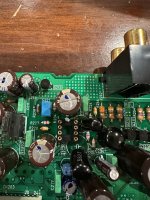
Phase two is waiting on some DIP extensions from Burson, it's too tight to install the V7 opamps due to the location of some capacitors. This will hopefully make it easier to swap without having to remove the analog audio board every time.
Please follow along for future comparisons between the analog audio board with the Burson opamps compared to the external Music Hall 25.2 Dac using the Sony as a transport connected through CoAx. I will also be comparing the older V6 Classic, to the V7 and OEM OPA2134.
Phase one has been completed, removing the soldered OPA2134 and replacing them with DIP 8 sockets.




Phase two is waiting on some DIP extensions from Burson, it's too tight to install the V7 opamps due to the location of some capacitors. This will hopefully make it easier to swap without having to remove the analog audio board every time.
Please follow along for future comparisons between the analog audio board with the Burson opamps compared to the external Music Hall 25.2 Dac using the Sony as a transport connected through CoAx. I will also be comparing the older V6 Classic, to the V7 and OEM OPA2134.
Hi dolsey01,
Thanks for taking the time to test and work with the Burson V7 op-amps. We appreciate your effort and feedback!
Warm regards,
Burson Audio Team
Thanks for taking the time to test and work with the Burson V7 op-amps. We appreciate your effort and feedback!
Warm regards,
Burson Audio Team
Hi guys,
If you're into audio modding and curious about upgrading your gear, we have a limited number of Burson V7 opamp samples available for fellow DIYers to test. If you'd like to try them in your project, feel free to send us a PM.
https://www.bursonaudio.com/products/supreme-sound-opamp-v5i/
https://www.bursonaudio.com/products/supreme-sound-opamp-v7/
Happy listening!
Burson Audio Team
If you're into audio modding and curious about upgrading your gear, we have a limited number of Burson V7 opamp samples available for fellow DIYers to test. If you'd like to try them in your project, feel free to send us a PM.
https://www.bursonaudio.com/products/supreme-sound-opamp-v5i/
https://www.bursonaudio.com/products/supreme-sound-opamp-v7/
Happy listening!
Burson Audio Team
The DIP-8 extensions have arrived from Burson Audio. Thank you again for supplying them! I would recommend that anyone using them plan on running a zip tie through the DIP-8 socket to attach them. It's possible my sockets were a little loose from the factory op-amps. Their final position would have them upside down, so I did not want to risk them coming loose.
My plan has had a slight unexpected change. I selected a few CDs from my most recent listening pile and listened to them using the factory op-amps through the analog output. Since I have owned this player, I have only used it as a transport feeding my Music Hall DAC 25.2. What happened next came as a surprise.
I began this experiment with the factory opamps installed playing back through the Sony's analog outputs. The first CD on the pile was Tok Tok Tok, Live & Intimate. I remembered this being a great-sounding CD, albeit a "Audiophile" type presentation. However, through the built-in analog section, it sounded small, closed-in, a bit harsh, bass light and overall very disappointing. Not at all what I remembered.
Audio memory is short, so I grabbed another CD I am very familiar with, Grace Potter and the Nocturnals, Nothing But The Water. Again, it sounded horrible. Grace Potter's voice was so harsh, I just couldn't listen anymore. I decided it was time for an alternative comparison. I installed the V7 Vivid op-amps and re-connected the Coaxial Digital cable to the Music Hall DAC. This configuration allowed me to compare the Sony's Analog output using the V7 Vivids to the Music Hall 25.2 DAC (also with the V7 Vivid installed). Having both sources connected to my Audio Research VSI-60 Integrated Amp, I can easily switch between inputs with the remote control. I matched their volume using a trusty Radio Shack SPL meter.
First up would be back to Grace Potter since the CD was still in the player and the sound was fresh in my memory. Right away there was a significant improvement using the Sony's analog section with V7 Vivid opamps. It was much more listenable, and sounded the way I expected. Grace's voice was forward, but no longer harsh and everything sounded richer and more dynamic.
Back to Tok Tok Tok with similar results, much smoother vocals and midrange, the bass notes were hitting lower and had a bit more bounce to them. The soundstage appeared to extend a little past the speakers now, before it was extremely narrow and flat.
I grabbed a CD that I knew would be a challenge, Lake Street Dive, Live At The Lizard Lounge. If I remember correctly, I purchased this as .WAV files from Lake Street Dive and later burned it to a CD. The recording quality is mediocre. I think it was recorded straight from their soundboard at the event. Rachael Price's voice is amazing and the trumpet would certainly provide a challenge to the Bursons, but even though the analog out of the Sony, it was very listenable and sounded as I had remembered.
I played a few additional CDs from the pile and the results remained consistent.
For each CD, I kept flipping back and forth between the inputs on my amp, and time after time was able to pick out which was the external DAC and which was the Sony analog outputs. I'm unable to see the inputs from my listening position, so I have to get up to see the front panel to confirm which helps make this somewhat of a blind test. While the difference wasn't night and day, it was perceivable with the DAC sounding better. The improvements were overall, including soundstage, bass extension, smoothness and dynamics. Everything just sounded a little bigger, a little deeper and maybe just a touch rolled off. The analog stage sounded flatter and still had a slight glare to it. It was a touch on the brighter side as well. Bass did not seem to hit as low and lost some of its bounce or dynamics.
My overall take from this experiment is, the swapping of the opamps was a very substantial improvement over the stock opamps. If you have no plan for an external DAC, and want an excellent sounding CD player for a bargain, this is definitely worth the time and expense for the upgrade.
The difference between the upgraded opamps in the analog output and the external DAC (also with the upgraded opamps) was less significant than the opamp upgrade alone. While it's hard to put a number value on a personal opinion, IMHO the DAC is a 10-15% improvement over the built-in analog section with the upgraded opamps. If you factor in the cost of the external DAC with the additional upgrades, it's 4-5 times the cost.
This was a fun and enlightening experiment and thank you again to Burson Audio for providing the opamps and dip extensions to make this possible.
Coming up next will be a comparison using the Burson V7 Classic version, and something tells me from my past experience with the previous V6 Classic version, that they may just be the perfect Goldilocks option for this vintage CD/DVD player.
Please watch this thread and come back to find out!
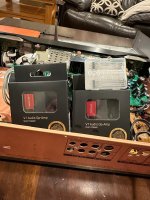
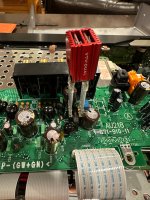
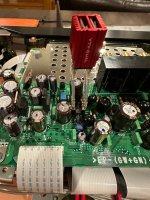
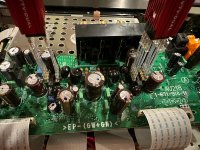
My plan has had a slight unexpected change. I selected a few CDs from my most recent listening pile and listened to them using the factory op-amps through the analog output. Since I have owned this player, I have only used it as a transport feeding my Music Hall DAC 25.2. What happened next came as a surprise.
I began this experiment with the factory opamps installed playing back through the Sony's analog outputs. The first CD on the pile was Tok Tok Tok, Live & Intimate. I remembered this being a great-sounding CD, albeit a "Audiophile" type presentation. However, through the built-in analog section, it sounded small, closed-in, a bit harsh, bass light and overall very disappointing. Not at all what I remembered.
Audio memory is short, so I grabbed another CD I am very familiar with, Grace Potter and the Nocturnals, Nothing But The Water. Again, it sounded horrible. Grace Potter's voice was so harsh, I just couldn't listen anymore. I decided it was time for an alternative comparison. I installed the V7 Vivid op-amps and re-connected the Coaxial Digital cable to the Music Hall DAC. This configuration allowed me to compare the Sony's Analog output using the V7 Vivids to the Music Hall 25.2 DAC (also with the V7 Vivid installed). Having both sources connected to my Audio Research VSI-60 Integrated Amp, I can easily switch between inputs with the remote control. I matched their volume using a trusty Radio Shack SPL meter.
First up would be back to Grace Potter since the CD was still in the player and the sound was fresh in my memory. Right away there was a significant improvement using the Sony's analog section with V7 Vivid opamps. It was much more listenable, and sounded the way I expected. Grace's voice was forward, but no longer harsh and everything sounded richer and more dynamic.
Back to Tok Tok Tok with similar results, much smoother vocals and midrange, the bass notes were hitting lower and had a bit more bounce to them. The soundstage appeared to extend a little past the speakers now, before it was extremely narrow and flat.
I grabbed a CD that I knew would be a challenge, Lake Street Dive, Live At The Lizard Lounge. If I remember correctly, I purchased this as .WAV files from Lake Street Dive and later burned it to a CD. The recording quality is mediocre. I think it was recorded straight from their soundboard at the event. Rachael Price's voice is amazing and the trumpet would certainly provide a challenge to the Bursons, but even though the analog out of the Sony, it was very listenable and sounded as I had remembered.
I played a few additional CDs from the pile and the results remained consistent.
For each CD, I kept flipping back and forth between the inputs on my amp, and time after time was able to pick out which was the external DAC and which was the Sony analog outputs. I'm unable to see the inputs from my listening position, so I have to get up to see the front panel to confirm which helps make this somewhat of a blind test. While the difference wasn't night and day, it was perceivable with the DAC sounding better. The improvements were overall, including soundstage, bass extension, smoothness and dynamics. Everything just sounded a little bigger, a little deeper and maybe just a touch rolled off. The analog stage sounded flatter and still had a slight glare to it. It was a touch on the brighter side as well. Bass did not seem to hit as low and lost some of its bounce or dynamics.
My overall take from this experiment is, the swapping of the opamps was a very substantial improvement over the stock opamps. If you have no plan for an external DAC, and want an excellent sounding CD player for a bargain, this is definitely worth the time and expense for the upgrade.
The difference between the upgraded opamps in the analog output and the external DAC (also with the upgraded opamps) was less significant than the opamp upgrade alone. While it's hard to put a number value on a personal opinion, IMHO the DAC is a 10-15% improvement over the built-in analog section with the upgraded opamps. If you factor in the cost of the external DAC with the additional upgrades, it's 4-5 times the cost.
This was a fun and enlightening experiment and thank you again to Burson Audio for providing the opamps and dip extensions to make this possible.
Coming up next will be a comparison using the Burson V7 Classic version, and something tells me from my past experience with the previous V6 Classic version, that they may just be the perfect Goldilocks option for this vintage CD/DVD player.
Please watch this thread and come back to find out!




Last edited:
Big thanks to dolsey01 for the detailed feedback, really appreciate you taking the time to share your experience!
Quick update for everyone: June samples have been sent out. If you’ve a cool project or interesting gear you'd like to test with our op-amps, feel free to PM us. We've a few free samples available every month.
Happy listening!
Burson Audio Team
Quick update for everyone: June samples have been sent out. If you’ve a cool project or interesting gear you'd like to test with our op-amps, feel free to PM us. We've a few free samples available every month.
Happy listening!
Burson Audio Team
The V7 Classics have arrived and since my last experiment's results left me feeling that the difference with the V7 Vivid in the DAC vs the V7 Vivid in the player were more similar than different, I chose to install the V7 Classic opamps in the player so that I could easily switch between the Vivid and Classic by changing the input on my integrated amp.
I went through the same pile of CD's that I used in the previous comparison. I have experience comparing the V6 Vivid and Classic, and while the difference was very audible and easy to discern, the difference between the V7 version is much more pronounced.
The comparison chart on the Burson website is very accurate at describing the differences, but I have to say I feel like the difference percentage is even higher than it shows.
The transparency of the V7V is much better than the V7C, the Classic has much less air around instruments and ambience.
Detail is also very easy to hear the difference between the two, the Classic almost sounds Tubey or Analog-like, it's rounded and rolled off.
Color and texture is where the V7C shines, it just has the right amount of midrange warmth and meat-on-the-bones sound. It's richer, but that warm blanket has a price.
Dynamics and soundstage are where the difference was the most dramatic for me, to the extent that it almost sounded like a different venue in Lake Street Dive's - You Go Down Smooth, the soundstage is much flatter and even a few feet lower in presentation and the trumpet and deep bass are much less pronounced. The room acoustics almost disappear completely and it sounds like they up and moved into the studio compared to a live venue. I was legitimately surprised at the difference.
The V7V cemented Vivid in its description. Vivid is the exact definition of the difference between the V7V and V7C. V7V sounds jump out at you, where the V7C is much more subdued.
These op-amps could very well be used as a tone control for an overly bright system by installing the V7 Classic. If your system sounds flat and boring, the V7 Vivid would be the ticket.
My results from this experiment will have me leaving the V7 Vivid in my DAC and the V7 Classic in the Sony player. I prefer the V7V for well-recorded music, but the V7C will really help 80s Rock or other poorly recorded music much more enjoyable. The V7C has a presentation I really enjoy, but for the majority of people, I would recommend the V7 Vivid, it does everything oh so well!
My next experiment will include the V6 Classic vs V7 Classic, so stay tuned!
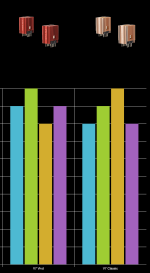
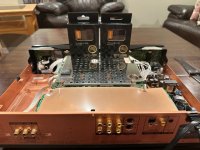
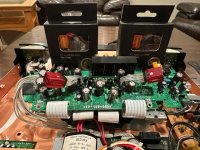
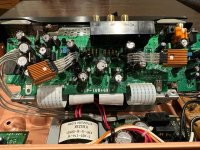
I went through the same pile of CD's that I used in the previous comparison. I have experience comparing the V6 Vivid and Classic, and while the difference was very audible and easy to discern, the difference between the V7 version is much more pronounced.
The comparison chart on the Burson website is very accurate at describing the differences, but I have to say I feel like the difference percentage is even higher than it shows.
The transparency of the V7V is much better than the V7C, the Classic has much less air around instruments and ambience.
Detail is also very easy to hear the difference between the two, the Classic almost sounds Tubey or Analog-like, it's rounded and rolled off.
Color and texture is where the V7C shines, it just has the right amount of midrange warmth and meat-on-the-bones sound. It's richer, but that warm blanket has a price.
Dynamics and soundstage are where the difference was the most dramatic for me, to the extent that it almost sounded like a different venue in Lake Street Dive's - You Go Down Smooth, the soundstage is much flatter and even a few feet lower in presentation and the trumpet and deep bass are much less pronounced. The room acoustics almost disappear completely and it sounds like they up and moved into the studio compared to a live venue. I was legitimately surprised at the difference.
The V7V cemented Vivid in its description. Vivid is the exact definition of the difference between the V7V and V7C. V7V sounds jump out at you, where the V7C is much more subdued.
These op-amps could very well be used as a tone control for an overly bright system by installing the V7 Classic. If your system sounds flat and boring, the V7 Vivid would be the ticket.
My results from this experiment will have me leaving the V7 Vivid in my DAC and the V7 Classic in the Sony player. I prefer the V7V for well-recorded music, but the V7C will really help 80s Rock or other poorly recorded music much more enjoyable. The V7C has a presentation I really enjoy, but for the majority of people, I would recommend the V7 Vivid, it does everything oh so well!
My next experiment will include the V6 Classic vs V7 Classic, so stay tuned!




- Home
- Source & Line
- Digital Source
- Sony DVP-S7700 Analog audio board upgrade with Burson V7 Opamps